Chiang Mai: The Sights
WAT A SIGHT: THE WATS
In the days of yore, kings played an important role in religion and, in Thailand, undertook to build temples and propagate Buddhism. As the one-time capital of the ancient kingdom of Lanna, Chiang Mai City which was carefully designed on cosmological principles, and its surrounds, was the location for many a royal-initiated or sponsored temple.
To say that there are many wats in Chiang Mai is an understatement. Particularly in the old city, there seemed to be a wat on every corner, and they were all within walking distance of our hotel (of course, that didn't stop us from taking a tuk-tuk sometimes!). I'm not too boned-up on religious architecture but I take pleasure in the visual treats per se. HM who usually hates "wats and wat nots" actually enjoyed these temple visits - compared to Bangkok's temples, these are relatively peaceful and free from the tourist hordes - but mostly for the quirky sights.
Wat Pan Tao
Of the four wats we visited, this is apparently the least famous of them all, not usually listed on must-see lists although right next door to the renowned Wat Chedi Luang. Being literally round the corner from Tamarind Village, we enjoyed walking past and wandering into it at odd moments. The fact that it was constructed entirely of wood made us feel like it was from a much older tradition.
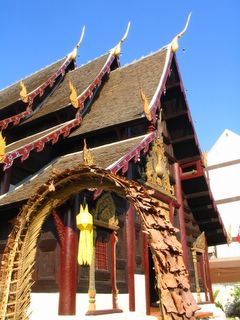
by day
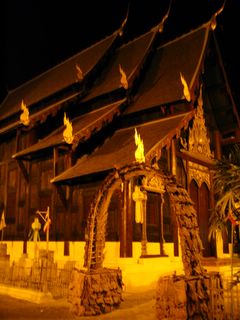
by night

holy ground

inside the viharn (main hall)
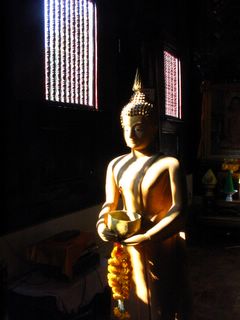
serenity

learning journey for young monks?
Wat Chedi Luang
Ravaged by a 16th-century earthquake, the Wat Chedi Luang is still an impressive edifice of Lanna architecture. The 20th century restoration effort, funded in part by UNESCO, stopped short of completion, because "no one knows how the original chedi looked like". Anyway, in my opinion, ruins stir the imagination much more than shiny refurbished buildings!

"another wat bites the dust" - HM

the Yang tree which legend claims protects Chiang Mai for as long as it stands
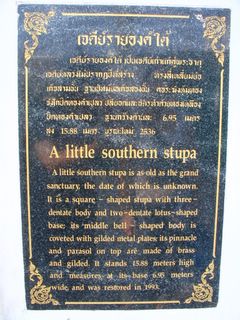
so cute, a little southern stupa...
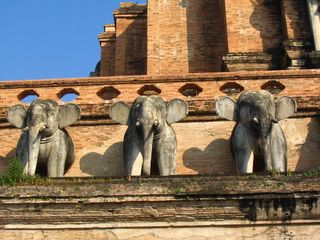
much-revered elephants
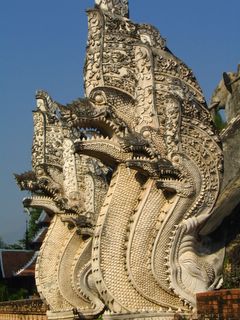
protected by naga
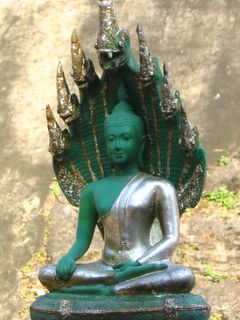
a copy of the Emerald Buddha, the original having been moved to Bangkok's Wat Phra Kaew
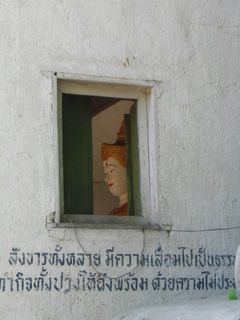
a peek inside one of the smaller buildings in the compound
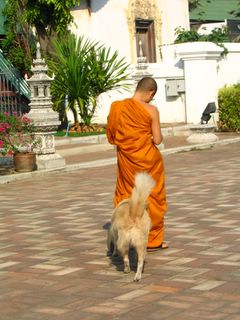
man's best friend
Wat Phra Singh
Of the four wats we visited, the Wat Phra Singh was the busiest, both in terms of worshipper and tourist traffic. It was certainly the largest of the four complexes and there was a fair bit to see.

the main facade

in the main viharn

monk baskets (everything a monk needs in a pail, available from a supermarket near you)
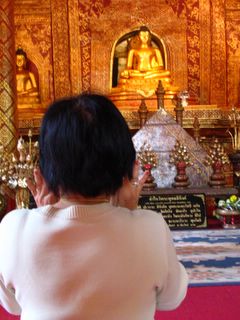
"Please hear my prayer..."
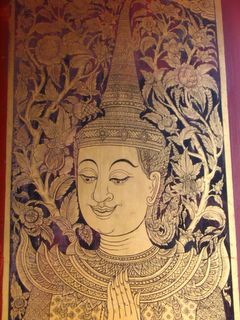
red lacquer and gold leaf, typical of Lanna style
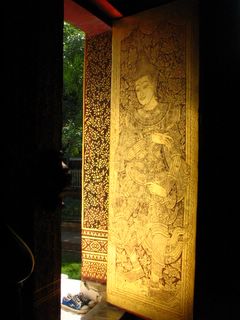
"Hey are those my shoes?"
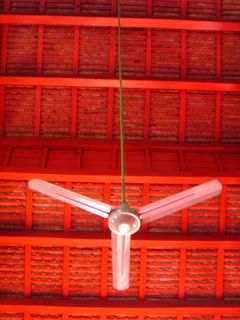
colour and contrast

gleaming in the sun
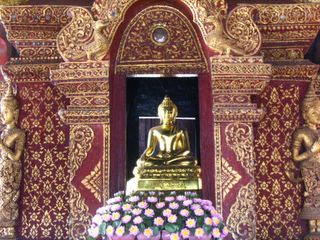
inside one of the smaller viharns
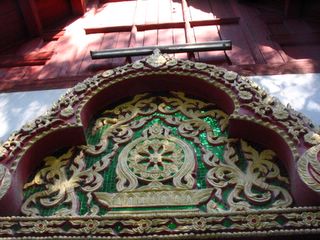
mirror inlay, another example of Lanna style

words of wisdom indeed
Wat Chiang Man (well, not quite...)
The first temple founded in Chiang Mai by the Lanna king, Mengrai, Wat Chiang Man is older than the city itself, dating back to the 13th century. Historical records speak of the temple playing residence to the king while he planned and built Chiang Mai City. Today, no longer the foremost temple it was in its heyday, Wat Chiang Man is still important for its historical significance (but admittedly little else).
I managed to squeeze in a visit on our last full day in Chiang Mai, while HM was busy at the spa, but by the time I reached there, the main viharn was locked. Not only that, the sun was setting and in the wrong position for photographs of the main building, THE Wat Chiang Man so to speak. Still, there's always something to look at....

a newer building within the compound, in a style that reminded us of Bangkok
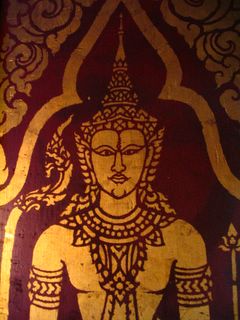
a gilded image from a door

time is of the essence perhaps

"You bad person, I smite you with my carriage"

photographers are such pests lol...

golden archway
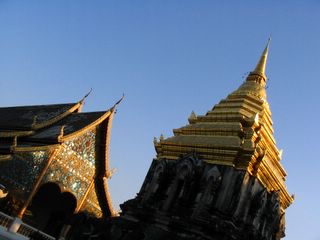
behind the main viharn

not just man's best friend

by the light of the setting sun
HISTORICAL SIGHTS
Chiang Mai City Arts and Cultural Centre
While HM was busy at the spa one day, I sneaked off to the erstwhile Chiang Mai City Arts and Cultural Centre. Although so named, the museum exhibits were really more historical in nature, documenting both the region's political, social and economic history. The first sequence of galleries brought us visitors through Chiang Mai's history, from its prehistorical roots to its founding by King Mengrai.
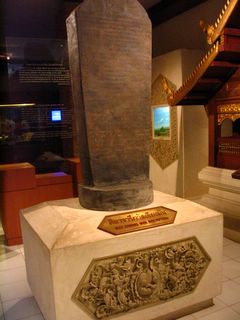
replica of the inscription documenting Chiang Mai's founding, the original being housed at Wat Chiang Man
And, taking into consideration our different learning styles, the galleries presented the information not just in one way, or two ways, or even three ways, but in four different ways: we visitors could watch videos narrated in Thai but with subtitles in English, listen to audio commentaries (with American/British accents), click our way through multimedia presentations, or read the notes mounted alongside the display of artifacts and maps. Four different ways, same information.
While informative and interesting enough, I thought the videos et al repetitive after some time. I was glad to move on to the dioramas depicting the social history of Northern Thailand, from founding to political union with modern Thailand.
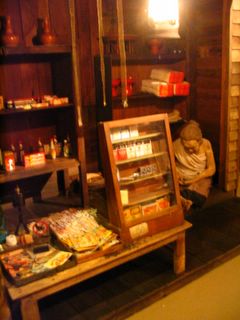
sundry shop

metalsmith at work

children playing with spiders
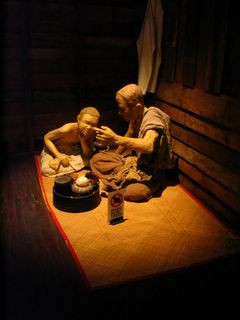
father and son at home
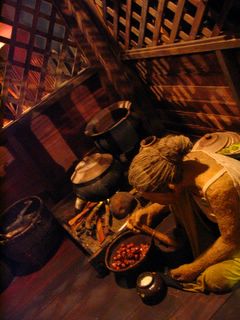
inside a traditional Thai kitchen

inside a typical Thai bedroom
The museum took great pains to impress on us how multicultural Chiang Mai is, how it embraces the traders of different ethnic origins including the hilltribe peoples of the region, what contributions these groups had made, how Chiang Mai has taken care of them... Of course, just from observing the faces around the city, Chiang Mai is obviously home to many peoples. Still, methinks they doth protest too much.
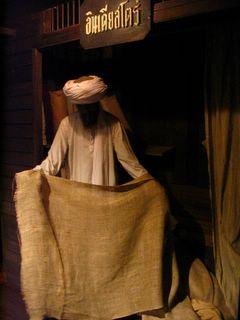
Indian textile merchant
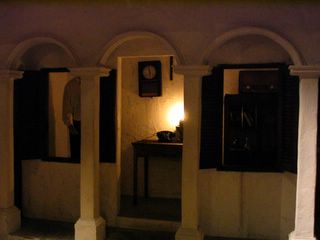
farang house

hilltribe woman with woven products

hilltribe farmer threshing sticky rice, traditional produce and staple of Northern Thailand
Alongside and in between the galleries, there was artwork and crafts of various sorts on display.

one of several Buddha statues
And when I was there, there was a demonstration of traditional weaving going on.

For 90B (SGD $3.60), the Chiang Mai City Arts and Cultural Centre was a cheap and enjoyable way to spend an afternoon, and an easy way to understand Chiang Mai a little better.
P.S. I quite liked this particular gallery which explained the connection between the Tai peoples who live in Northern Thailand, up through Indochina and into Southern China. There was even an audio station where one could listen to the various languages in the Tai family such as Laos, Isaan and Thai.
Three Kings Monument
Right in front of the Chiang Mai City Arts and Cultural Centre is the Three Kings Monument, a reminder to the people of the Chiang Mai of the city's founding fathers, King Mengrai and two of his allies, King Ramkhamhaeng of Sukhotai and King Ngam Muang of Payao. As an icon, it certainly beats the Merlion...

still revered after all these years
DOI INTHANON NATIONAL PARK
I daresay most people who visit Chiang Mai do at least one of two things - go to one of the elephant parks or visit Wat Doi Suthep, Chiang Mai's iconic temple located just outside the city. We did neither. With only four full days in CM, we had to pick and choose what we wanted to see and do. We had already "done" a couple of wats and I didn't think HM's patience would stretch to another one. And let's face it, elephants being elephants, elephant parks are by nature smelly affairs, and we weren't up to anything too, uh, rugged. Shop, eat and potter being our usual holiday routine, we wanted nothing too strenuous which meant no trekking or rafting. A cookery class seemed like a really good idea but the weather was so nice, neither of us wanted to spend an entire day indoors. In the end, we plumbed for a day out to the Doi Inthanon National Park, Doi Inthanon being Thailand's highest peak. At least we would get to see a little of the highlands that make Northern Thailand distinctive and contemplate the possibility of a return visit including a stay in a highland resort perhaps...
For 1000B (SGD $50) each, the tour company promised to deliver two waterfalls, visits to a Karen village and a royal agricultural project, the highest point in Thailand, two chedis (oh dear, poor HM), and of course lunch. Oh, and if that sounds expensive, the tour company explained that 200B (SGDE $10) each would go towards the entrance fee to the park. Ok lah...
The day out started with a "tour" of Chiang Mai City. We should have anticipated it when, surprise surprise, our guides for the day, "Call me Tuk" and assistant Louis, arrived early to pick us up from the hotel. We discovered that we were the first... For the next one hour, we rode around in the mini-van picking up our fellow tour mates, including one who had grossly overslept. As Tuk pointed out, we were a veritable United Nations that morning - one American, one Quebecois (French Canadian) working in Las Vegas, one Jewish Quebecois working in Chicago, one Filipino American, one Italian living in Australia, one Australian of Fijian Indian origin, one Belgian and us Singaporeans. After we had finally picked up the Belgian with the hangover, we were finally on our way.
Vachiratan Waterfall
Our first stop was at this waterfall where we were given half an hour to look around. The first thing we all did was to go to the loo! The waterfall itself is a hop and skip and jump from the public carpark.
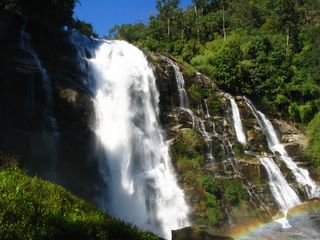
apparently three people have died taking photographs here...
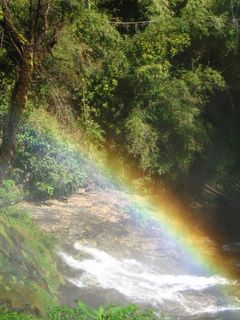
magical moment
The top of the waterfall was accessible via a staircase. Sadly, I could only huff and puff my way up halfway, and then I spent the next half an hour feeling sick from the exertion. Was it the altitude or sheer lack of fitness on my part?
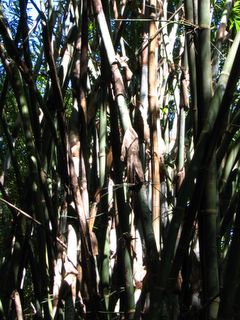
bamboo groves
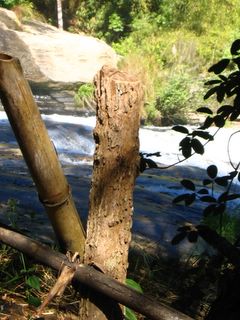
idyllic moment
A Visit to a Karen Village
The next stop was a Karen village of approximately 90 people. According to Tuk, the Karen people's main source of income was the farming of sticky rice supplemented by indigenous crafts such as weaving.
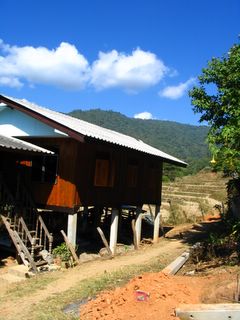
a newer house in the village (note the rice fields in the background)
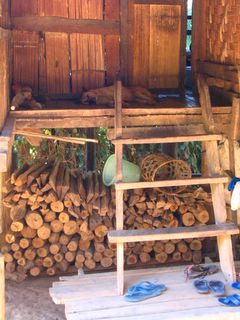
an older house, with firewood and a traditional, uh, security system
Of course there was the obligatory visit to the "souvenir shop". We considered buying something, but couldn't find anything in the right size (we were thinking yoga mat) and didn't want to buy something we didn't like just to do the right thing.
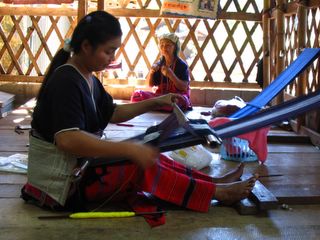
traditional Karen weaving - primitive...

but effective
In the fifteen minutes we were there, we didn't meeet anyone other than the women running the "souvenir shop". I felt that, if we had had the opportunity to interact with more villagers or observe their daily activites, it would have been a more authentic experience, but at least we didn't have to face the begging children that some of these villages are noted for or the freakshow of the long-necked tribe (I wonder how they feel being made objects of curiosity).
Sriphum Waterfall
By the time we reached this next waterfall, I had recovered from the previous exertion. This time round, I took my time climbing up and down, pausing to take photos on the way.

vantage point
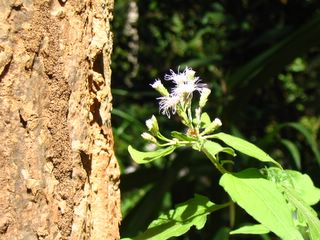
"You're so big and I'm so small..."

coniferous pines - a sign of the rising altitude
Inthanon Royal Research Station
There was one more stop to go before lunch and that was one of the agricultural projects sponsored by the Thai Royal Family to offer viable economic alternatives to the impoverished hilltribes who would otherwise continue farming poppy.
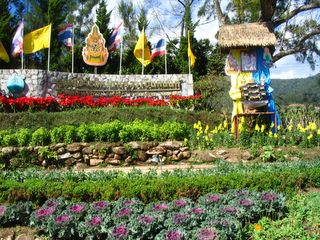
Inthanon Royal Project
This particular project involved research into crops and flowering plants from temperate climates, to find out which would grow well in this region.

greenhouse after greenhouse
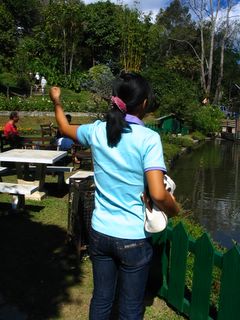
"Tuk", our tour guide issuing instructions before giving us time to explore
We headed for a taste of Doi Kham coffee.

hey, time for a cuppa
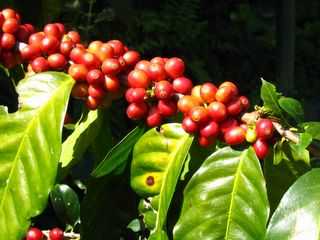
coffee beans in situ
Armed with an iced latte (remember "mai nam tan"!), we took a walk round the greenhouses.

how weird to see unpotted poinsetta
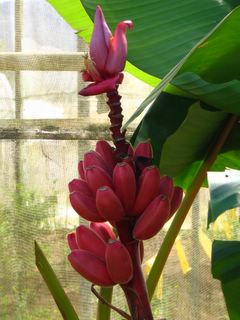
red bananas?
We weren't sure what the plants and flowers were called, give or take a peony or two, but we didn't need to know their names to admire their beauty.
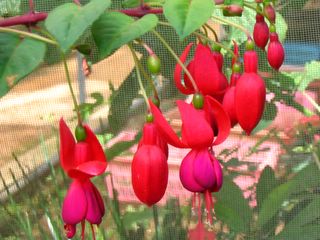
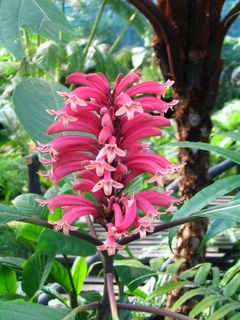

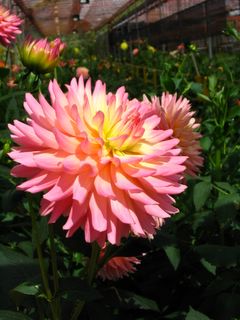
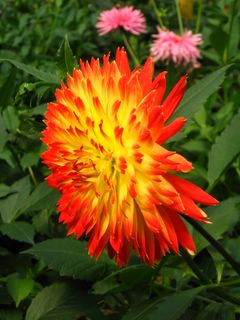

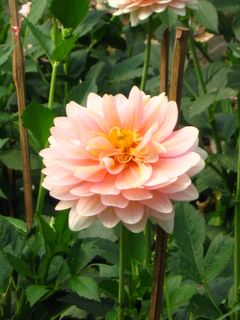
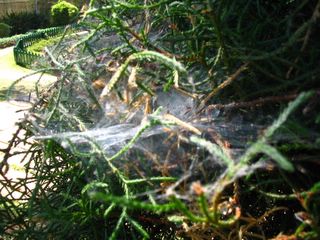
cobwebs
One interesting sight was that of lettuces of various sorts planted along the roadside, as part of the landscaping, much like flowering plants. Who knew vegetables could be aesthetic?


It would have been fun to spend more time at the royal project, but lunch beckoned, and so we piled back into the mini-van and headed to our roadside restaurant.

"...all that I survey..."
Highest Point of Thailand
After lunch, it was a bit of a drive but we finally arrived at the tourist-friendly "peak", 2565m above sea-level.

'nuff said
The mountain and the surrounding nature park are named after King Inthanon, the last king of Northern Thailand who so loved the place he commanded that his ashes be interred there after death.

shrine for King Inthanon

12 degrees Celsius that day, 3 degrees two weeks later
It was cool that day, lovely for a walk through the unique flora and fauna of Doi Inthanon.
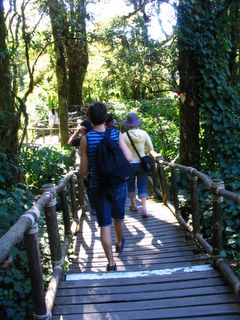
hi ho, hi ho, when off to work we go
After a short walk, we arrived at what can best be described as a tourist rest stop, complete with exhibition, souvenir and snack shops, and of course public toilets.
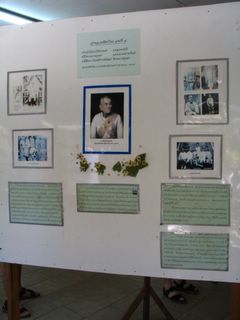
About King Inthanon
A funny thing happened when the birdlife that Doi Inthanon is renowned for made an appearance. For as long as we were up there, hordes of tourists dashed excitedly from bush to bush, following the flitting birds around and snapping away.
My dinky camera only managed to capture this picture:
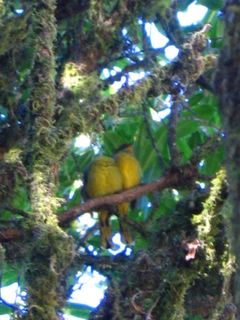
love birds of some sort, possibly yellow-bellied fantails
The one that got away was a Green-tailed Sunbird...
Phra Mahathat Methanidon and Phra Mahathat Nopphon Phumisiri
Finally, we made our way to the twin chedis, built by the Royal Thai Airforce to commemorate the 60th birthdays of their Royal Highnesses, King Bhumipol and Queen Sirikit.
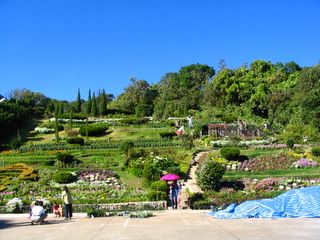
manmade beauty
Check out the size of these birthday presents:
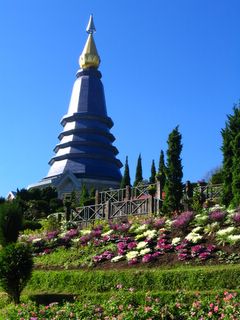
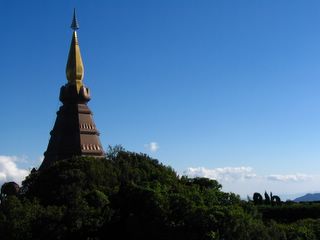
The interiors were beautifully decorated...
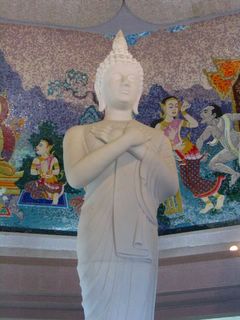

... while the grounds were beautifully landscaped.
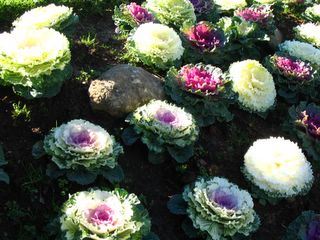
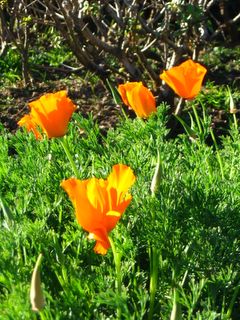
But the stars of the "show" were the rolling mountains unfolding and undulating as far as the eye could see.
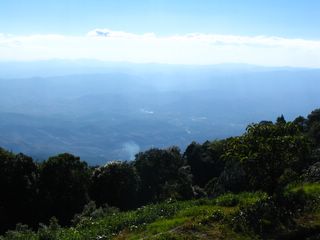
towards Mae Hon Son and the border with Myanmar
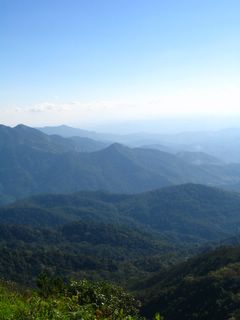
I wouldn't have missed this for the world
It was difficult to tear ourselves from those views but leave we had to. As it was, we were the last back to the meeting point from which we'd take a sangthaew back down to the carpark that doubled up as a helipad, where our minivan was waiting to take us back to Chiang Mai City.

a faster way home, anyone?
In the days of yore, kings played an important role in religion and, in Thailand, undertook to build temples and propagate Buddhism. As the one-time capital of the ancient kingdom of Lanna, Chiang Mai City which was carefully designed on cosmological principles, and its surrounds, was the location for many a royal-initiated or sponsored temple.
To say that there are many wats in Chiang Mai is an understatement. Particularly in the old city, there seemed to be a wat on every corner, and they were all within walking distance of our hotel (of course, that didn't stop us from taking a tuk-tuk sometimes!). I'm not too boned-up on religious architecture but I take pleasure in the visual treats per se. HM who usually hates "wats and wat nots" actually enjoyed these temple visits - compared to Bangkok's temples, these are relatively peaceful and free from the tourist hordes - but mostly for the quirky sights.
Wat Pan Tao
Of the four wats we visited, this is apparently the least famous of them all, not usually listed on must-see lists although right next door to the renowned Wat Chedi Luang. Being literally round the corner from Tamarind Village, we enjoyed walking past and wandering into it at odd moments. The fact that it was constructed entirely of wood made us feel like it was from a much older tradition.

by day

by night

holy ground

inside the viharn (main hall)

serenity

learning journey for young monks?
Wat Chedi Luang
Ravaged by a 16th-century earthquake, the Wat Chedi Luang is still an impressive edifice of Lanna architecture. The 20th century restoration effort, funded in part by UNESCO, stopped short of completion, because "no one knows how the original chedi looked like". Anyway, in my opinion, ruins stir the imagination much more than shiny refurbished buildings!

"another wat bites the dust" - HM

the Yang tree which legend claims protects Chiang Mai for as long as it stands

so cute, a little southern stupa...

much-revered elephants

protected by naga

a copy of the Emerald Buddha, the original having been moved to Bangkok's Wat Phra Kaew

a peek inside one of the smaller buildings in the compound

man's best friend
Wat Phra Singh
Of the four wats we visited, the Wat Phra Singh was the busiest, both in terms of worshipper and tourist traffic. It was certainly the largest of the four complexes and there was a fair bit to see.

the main facade

in the main viharn

monk baskets (everything a monk needs in a pail, available from a supermarket near you)

"Please hear my prayer..."

red lacquer and gold leaf, typical of Lanna style

"Hey are those my shoes?"

colour and contrast

gleaming in the sun

inside one of the smaller viharns

mirror inlay, another example of Lanna style

words of wisdom indeed
Wat Chiang Man (well, not quite...)
The first temple founded in Chiang Mai by the Lanna king, Mengrai, Wat Chiang Man is older than the city itself, dating back to the 13th century. Historical records speak of the temple playing residence to the king while he planned and built Chiang Mai City. Today, no longer the foremost temple it was in its heyday, Wat Chiang Man is still important for its historical significance (but admittedly little else).
I managed to squeeze in a visit on our last full day in Chiang Mai, while HM was busy at the spa, but by the time I reached there, the main viharn was locked. Not only that, the sun was setting and in the wrong position for photographs of the main building, THE Wat Chiang Man so to speak. Still, there's always something to look at....

a newer building within the compound, in a style that reminded us of Bangkok

a gilded image from a door

time is of the essence perhaps

"You bad person, I smite you with my carriage"

photographers are such pests lol...

golden archway

behind the main viharn

not just man's best friend

by the light of the setting sun
HISTORICAL SIGHTS
Chiang Mai City Arts and Cultural Centre
While HM was busy at the spa one day, I sneaked off to the erstwhile Chiang Mai City Arts and Cultural Centre. Although so named, the museum exhibits were really more historical in nature, documenting both the region's political, social and economic history. The first sequence of galleries brought us visitors through Chiang Mai's history, from its prehistorical roots to its founding by King Mengrai.

replica of the inscription documenting Chiang Mai's founding, the original being housed at Wat Chiang Man
And, taking into consideration our different learning styles, the galleries presented the information not just in one way, or two ways, or even three ways, but in four different ways: we visitors could watch videos narrated in Thai but with subtitles in English, listen to audio commentaries (with American/British accents), click our way through multimedia presentations, or read the notes mounted alongside the display of artifacts and maps. Four different ways, same information.
While informative and interesting enough, I thought the videos et al repetitive after some time. I was glad to move on to the dioramas depicting the social history of Northern Thailand, from founding to political union with modern Thailand.

sundry shop

metalsmith at work

children playing with spiders

father and son at home

inside a traditional Thai kitchen

inside a typical Thai bedroom
The museum took great pains to impress on us how multicultural Chiang Mai is, how it embraces the traders of different ethnic origins including the hilltribe peoples of the region, what contributions these groups had made, how Chiang Mai has taken care of them... Of course, just from observing the faces around the city, Chiang Mai is obviously home to many peoples. Still, methinks they doth protest too much.

Indian textile merchant

farang house

hilltribe woman with woven products

hilltribe farmer threshing sticky rice, traditional produce and staple of Northern Thailand
Alongside and in between the galleries, there was artwork and crafts of various sorts on display.

one of several Buddha statues
And when I was there, there was a demonstration of traditional weaving going on.

For 90B (SGD $3.60), the Chiang Mai City Arts and Cultural Centre was a cheap and enjoyable way to spend an afternoon, and an easy way to understand Chiang Mai a little better.
P.S. I quite liked this particular gallery which explained the connection between the Tai peoples who live in Northern Thailand, up through Indochina and into Southern China. There was even an audio station where one could listen to the various languages in the Tai family such as Laos, Isaan and Thai.
Three Kings Monument
Right in front of the Chiang Mai City Arts and Cultural Centre is the Three Kings Monument, a reminder to the people of the Chiang Mai of the city's founding fathers, King Mengrai and two of his allies, King Ramkhamhaeng of Sukhotai and King Ngam Muang of Payao. As an icon, it certainly beats the Merlion...

still revered after all these years
DOI INTHANON NATIONAL PARK
I daresay most people who visit Chiang Mai do at least one of two things - go to one of the elephant parks or visit Wat Doi Suthep, Chiang Mai's iconic temple located just outside the city. We did neither. With only four full days in CM, we had to pick and choose what we wanted to see and do. We had already "done" a couple of wats and I didn't think HM's patience would stretch to another one. And let's face it, elephants being elephants, elephant parks are by nature smelly affairs, and we weren't up to anything too, uh, rugged. Shop, eat and potter being our usual holiday routine, we wanted nothing too strenuous which meant no trekking or rafting. A cookery class seemed like a really good idea but the weather was so nice, neither of us wanted to spend an entire day indoors. In the end, we plumbed for a day out to the Doi Inthanon National Park, Doi Inthanon being Thailand's highest peak. At least we would get to see a little of the highlands that make Northern Thailand distinctive and contemplate the possibility of a return visit including a stay in a highland resort perhaps...
For 1000B (SGD $50) each, the tour company promised to deliver two waterfalls, visits to a Karen village and a royal agricultural project, the highest point in Thailand, two chedis (oh dear, poor HM), and of course lunch. Oh, and if that sounds expensive, the tour company explained that 200B (SGDE $10) each would go towards the entrance fee to the park. Ok lah...
The day out started with a "tour" of Chiang Mai City. We should have anticipated it when, surprise surprise, our guides for the day, "Call me Tuk" and assistant Louis, arrived early to pick us up from the hotel. We discovered that we were the first... For the next one hour, we rode around in the mini-van picking up our fellow tour mates, including one who had grossly overslept. As Tuk pointed out, we were a veritable United Nations that morning - one American, one Quebecois (French Canadian) working in Las Vegas, one Jewish Quebecois working in Chicago, one Filipino American, one Italian living in Australia, one Australian of Fijian Indian origin, one Belgian and us Singaporeans. After we had finally picked up the Belgian with the hangover, we were finally on our way.
Vachiratan Waterfall
Our first stop was at this waterfall where we were given half an hour to look around. The first thing we all did was to go to the loo! The waterfall itself is a hop and skip and jump from the public carpark.

apparently three people have died taking photographs here...

magical moment
The top of the waterfall was accessible via a staircase. Sadly, I could only huff and puff my way up halfway, and then I spent the next half an hour feeling sick from the exertion. Was it the altitude or sheer lack of fitness on my part?

bamboo groves

idyllic moment
A Visit to a Karen Village
The next stop was a Karen village of approximately 90 people. According to Tuk, the Karen people's main source of income was the farming of sticky rice supplemented by indigenous crafts such as weaving.

a newer house in the village (note the rice fields in the background)

an older house, with firewood and a traditional, uh, security system
Of course there was the obligatory visit to the "souvenir shop". We considered buying something, but couldn't find anything in the right size (we were thinking yoga mat) and didn't want to buy something we didn't like just to do the right thing.

traditional Karen weaving - primitive...

but effective
In the fifteen minutes we were there, we didn't meeet anyone other than the women running the "souvenir shop". I felt that, if we had had the opportunity to interact with more villagers or observe their daily activites, it would have been a more authentic experience, but at least we didn't have to face the begging children that some of these villages are noted for or the freakshow of the long-necked tribe (I wonder how they feel being made objects of curiosity).
Sriphum Waterfall
By the time we reached this next waterfall, I had recovered from the previous exertion. This time round, I took my time climbing up and down, pausing to take photos on the way.

vantage point

"You're so big and I'm so small..."

coniferous pines - a sign of the rising altitude
Inthanon Royal Research Station
There was one more stop to go before lunch and that was one of the agricultural projects sponsored by the Thai Royal Family to offer viable economic alternatives to the impoverished hilltribes who would otherwise continue farming poppy.

Inthanon Royal Project
This particular project involved research into crops and flowering plants from temperate climates, to find out which would grow well in this region.

greenhouse after greenhouse

"Tuk", our tour guide issuing instructions before giving us time to explore
We headed for a taste of Doi Kham coffee.

hey, time for a cuppa

coffee beans in situ
Armed with an iced latte (remember "mai nam tan"!), we took a walk round the greenhouses.

how weird to see unpotted poinsetta

red bananas?
We weren't sure what the plants and flowers were called, give or take a peony or two, but we didn't need to know their names to admire their beauty.








cobwebs
One interesting sight was that of lettuces of various sorts planted along the roadside, as part of the landscaping, much like flowering plants. Who knew vegetables could be aesthetic?


It would have been fun to spend more time at the royal project, but lunch beckoned, and so we piled back into the mini-van and headed to our roadside restaurant.

"...all that I survey..."
Highest Point of Thailand
After lunch, it was a bit of a drive but we finally arrived at the tourist-friendly "peak", 2565m above sea-level.

'nuff said
The mountain and the surrounding nature park are named after King Inthanon, the last king of Northern Thailand who so loved the place he commanded that his ashes be interred there after death.

shrine for King Inthanon

12 degrees Celsius that day, 3 degrees two weeks later
It was cool that day, lovely for a walk through the unique flora and fauna of Doi Inthanon.

hi ho, hi ho, when off to work we go
After a short walk, we arrived at what can best be described as a tourist rest stop, complete with exhibition, souvenir and snack shops, and of course public toilets.

About King Inthanon
A funny thing happened when the birdlife that Doi Inthanon is renowned for made an appearance. For as long as we were up there, hordes of tourists dashed excitedly from bush to bush, following the flitting birds around and snapping away.
My dinky camera only managed to capture this picture:

love birds of some sort, possibly yellow-bellied fantails
The one that got away was a Green-tailed Sunbird...
Phra Mahathat Methanidon and Phra Mahathat Nopphon Phumisiri
Finally, we made our way to the twin chedis, built by the Royal Thai Airforce to commemorate the 60th birthdays of their Royal Highnesses, King Bhumipol and Queen Sirikit.

manmade beauty
Check out the size of these birthday presents:


The interiors were beautifully decorated...


... while the grounds were beautifully landscaped.


But the stars of the "show" were the rolling mountains unfolding and undulating as far as the eye could see.

towards Mae Hon Son and the border with Myanmar

I wouldn't have missed this for the world
It was difficult to tear ourselves from those views but leave we had to. As it was, we were the last back to the meeting point from which we'd take a sangthaew back down to the carpark that doubled up as a helipad, where our minivan was waiting to take us back to Chiang Mai City.

a faster way home, anyone?
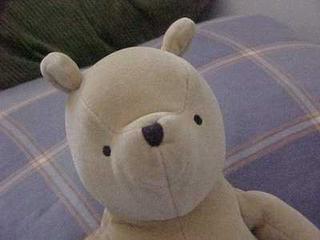

0 Comments:
Post a Comment
<< Home